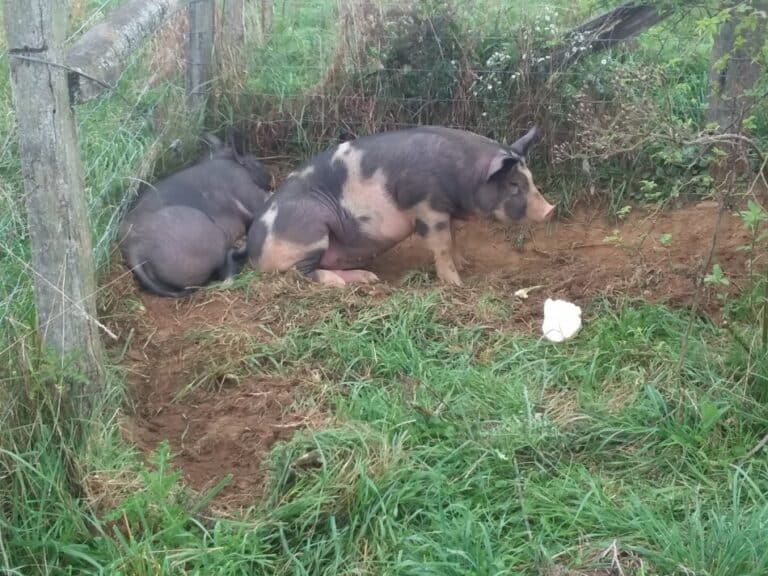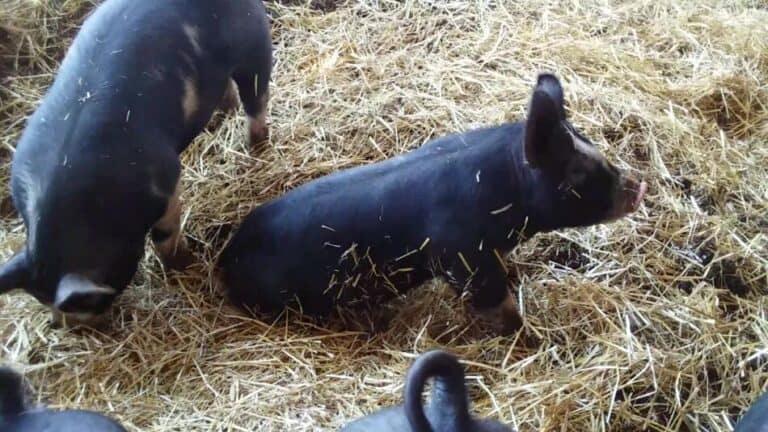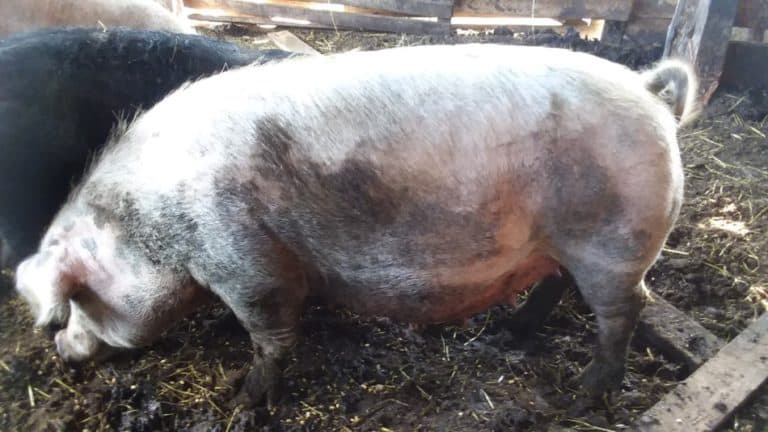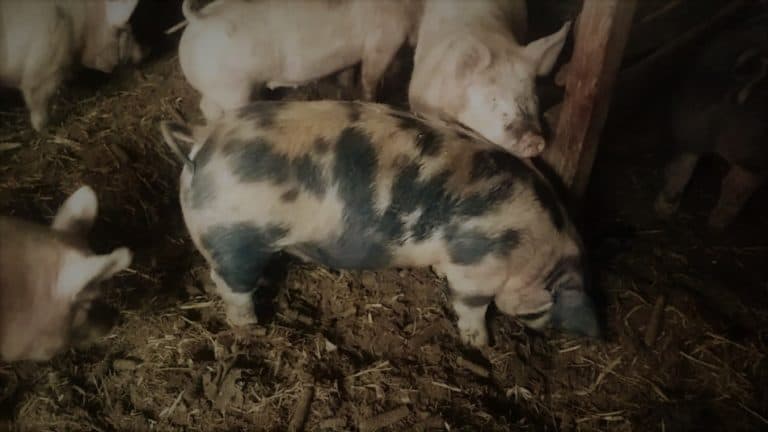The Best Pigs For Breeding Stock: A Beginner’s Guide
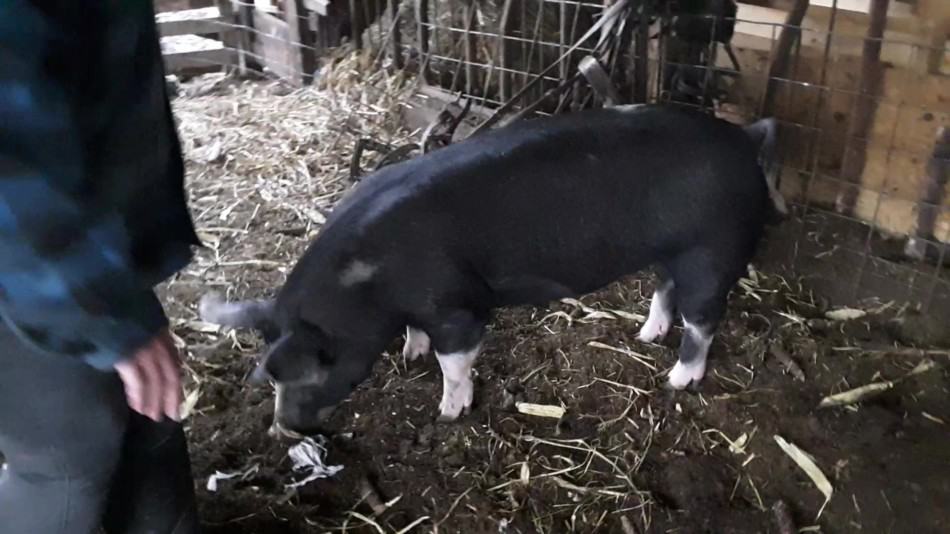
Choosing breeding stock is exciting and a time that will hopefully mark the start of a new successful business for you and your farm! You’re bound to have a lot of choices and questions, let’s get going!
Choose breeding stock pigs by defining what you want (your priority), listing out any thing you do not want (unacceptable traits) then use those two metrics to find the breed or crossbred that will perform best in your management system.
Are you looking for more pigs per litter, ability to do it all on pasture, wider bodied pigs or maybe even purebreds?
To get the best pigs for you, you are going to have to do a bit of thinking and decide what you really need in your pigs.
Is Raising Pigs For Meat Worth It? goes over your budget for getting a few feeder pigs into your freezer. I know you want breeding stock, but read this as well, so you’ll have the full scoop on costs.
Basically, the process for selecting pig breeding stock going to look like this:
- Decide your priority for your breeding stock
- List out any unacceptable traits
- Choose a few breeds or crossbreds that will meet your priority selection
If all of this breeding stock talk is completely new to you, read my article Pig Reproduction: Beginner Basics.
Matching your priority to the pigs
It’s so tempting to listen to individuals or associations telling you this is the perfect breed for everyone. That would be great, if it were true.
Here’s the truth-No one breed or cross of breeds is perfect for everyone.
Every breed and/or cross has advantages and disadvantages, this is what makes the breed special, that it is different from all the other breeds.
What breed will suit you and your farm the best? How do you choose?
Choose a priority for your pig operation
Pick one trait. Just one.
This is your priority and all choices you make from here out should be made to keep your breeding operation in line with your priority.
There are many possible choices and characteristics to focus on, so you need to know what you want in order to keep heading toward your ideal.
Consider your pig management plans
The first consideration is you and your planned management system.
You and your pigs will be much happier if you choose pigs that are already inclined to do the things you want your pigs to do.
For instance: if you want to do mostly outdoor farrowing and raising choose a hardier breed, like a Duroc.
If you want to raise completely confined hogs and are looking for the highest litter numbers consider a Landrace.
Neither breed is better or worse than the other, they are just bred over decades to be good at something in a specific situation.
It only makes sense to have that ability working in your favor!
Now is the time to decide-what is the priority of your pig operation? Don’t make any further decisions until you have this answer.
Make a list of unacceptable traits for pigs
Just as important as choosing which characteristics you want to have in your breeding stock is to know and steer clear of any characteristics you definitely do not want to have in your pigs.
Poor pork quality is unacceptable to me
Some breeds of pigs have a gene called the Napole gene, that makes the meat pale and tasteless. Yikes, I don’t want to have that anywhere near my breeding stock.
The Napole gene can be tested for and is listed out in the descriptions in any sire/A.I. catalogs. You can also ask. This is a big deal and your breeder or boar stud (place that sells boar semen) should know about it.
It’s important to me to have high quality, meaty pigs and that means high quality pork, as evaluated from an eater’s perspective.
I want pork from my pigs to taste amazing. Any genetics that negatively affect pork quality are not acceptable to me in my breeding stock.
Example trait: pasture farrowing
If pasture farrowing is one of the key attributes to your system of raising pigs, then any sows or gilts that require indoor farrowing to raise an acceptable litter are out.
They can not give you what you need.
You need to have access to replacement boars, sows and gilts
Another, often overlooked complication with breeding stock is getting new bloodlines, especially boars. Can you get a new unrelated boar when you decide to replace your current boar?
This can be a more significant problem for the rare or unusual breeds, especially breeds that require specific family line breeding schemes to produce piglets that qualify to be registered.
Do you have to drive multiple states away to get new breeding stock? If so, are you willing and capable of getting it done?
While this is not a trait of the pigs, it is a complication with the breed. One that you will not be able to avoid, so I put it in for you to think about.
Put in some time here. When it comes to this sort of thing, I make a list. Something about having it written out helps me sort out my thoughts.
Remember, you are the one who has to live with your choices, so choose the things that are important to you. Forget the hype and concentrate on the traits you really need to be successful.
With your priority decided, on to pig breed selection
One of the amazing parts of looking into animals and the different breeds of livestock raised all over the world is to see that there really is a pig suited for every area.
Your job is to match up the inborn characteristics of the pigs with the characteristics of a pig that you want to raise.
I do need to mention that all priorities come with a trade off, or two. Your chosen breed or breeding line can not be the best at everything, that is impossible.
When you choose the main thing you want to focus on with your pig operation you are also choosing your biggest challenge. Just like for people, more time with family means less time with buddies or at work.
Here are two examples, just to get you thinking.
Example Priority: pigs raised with as little feed purchased as possible
Potential answer-consider the Guinea Hog. It’s small size makes it able to get most of it’s own food, if given the area to roam.
It will be an easier animal to handle for home butchering and you will not need to get a huge freezer to store the meat.
Trade off-small body size means more animals to butcher to feed the family for the year.
Also, if you plan to sell finished pigs, feeder pigs or breeding stock not everyone will like a smaller bodied animal.
Example Priority: big bodied pig that will finish at a higher weight than most pigs
Potential answer-consider Poland China.
These are big framed pigs that are known for growing well and are a bit harder to find, depending upon your area, giving you an unusual pig to raise and talk about.
Trade off-will take more feed to finish out than a smaller framed animal.
Not everyone wants a big framed pig (if you are hoping to sell feeder pigs or breeding stock), since it will take longer to finish than other breeds.
For some customers the huge hams, for instance, are just too big for their household needs.
Once again, there is no right or wrong here, just make sure you choose the pig that will be most likely to give you what you want.
You can choose anything you can afford and take care of, of course.
Choose pig breed that best matches your needs
Do yourself a favor and start with pigs that are as close to what you want as you can.
Most any breed can be worked with, that’s not the important part here. It’s a matter of what you’ll have to do to make it work.
Looking for a bit more help here? Read my article Choosing The Best Pig Breed For Meat.
Consider your farm and your pig management
This is potentially a difficult section to read for anyone who has already singled out a specific breed.
Without considering the management system the pigs will be raised in or the advantages and challenges of the home farm region and area, you can be facing an uphill battle with your pigs.
And it will self inflicted!
Match the natural attributes and challenges of your farm to the pigs you choose.
Going the other way, choosing the pigs and adapting the farm is doable, sure, but more expensive and frustrating.
Consider a specific pig breed that matches your priority
Now that you have your priority decided, it’s time to start looking for breeds or operations that you should consider selecting breeding stock from.
There are many breed or crossbreed options and reasons for using or not using them. If you look at a neighbor’s pig operation and like what you see-easy answer, get the same pigs!
If you don’t have an obvious mentor, here are some general choices to get you started.
Remember-far more important than breed is that the management system you are using matches the natural inclinations of the pigs.
Normally, there will be multiple breeds that would all work equally well for you.
There are All Round Great Pigs
- Yorkshire
- Chester White
- Crossbred-especially one your neighbors are successfully using!
Some pigs are Meat Specialists
- Berkshire
- Duroc
- Hampshire
- Crossbred meat breed
Certain pig breeds are Hardy
- Yorkshire
- Duroc
- Berkshire
- Crossbred of the above
Some pigs are Large Litter Producers
- Landrace (for indoor production)
- Yorkshire
- Crossbred of the above pigs
Rare breeds are a pig breeding stock option
- Tamworth
- Mulefoot
- Guinea Hog
- Hereford
- Mangalista
- Large Black
Evaluate pigs in person before you buy
It would be nice if after all of the planning and thinking you have put into your pigs, that you would be done and the selection of the best pigs for you would be easy from here out.
That would be nice, but it’s not the case. Now we move from paper to real world, things are about to get exciting!
Before you go any further, please hear this: always be ready to walk away. Do not compromise on the quality of your breeding stock.
I know how it feels to go to a farm and be super excited and not see what you were hoping for yet really want to buy those pigs anyway. Don’t, it will come back to bite you.
Sort things out the best you can on the phone or in text messages then you’ll need to actually see the pigs in person.
Here’s what to look for when you get there:
- Look around at the farm and the pigs-are they healthy and well tended?
- Compare individual pigs in their peer group regarding size and structure
- Gilts should be feminine and well grown
- Sows should be in good body condition
- Boars should be masculine and well grown for age
- All pigs should be alert and interested in you, but not aggressive
Evaluating the pig farm you are buying from
Look around at the farm and the pigs. How do things look? Perfect is not what you are looking for here, look for well cared for happy and healthy pigs.
Are the pigs raised in the way you plan to raise yours?
This isn’t mandatory, however, the closer your plan is to the current way the pigs are raised the easier the change to your farm will be for the pigs.
And the more likely you will be happy with your purchase!
Deal Breakers-unthrifty, sick or dead pigs; overwhelming manure smell-you should smell pig not large amounts of manure
Evaluate individual pigs
Most likely, the pigs you are looking at will be in a peer group, meaning housed with other pigs of their age and sex.
Be sure to:
- Ask how close in age the pigs are to each other
- Ask what he thinks are the best pigs in the group and why.
You’ll learn a lot about how the breeder selects pigs by listening to him/her tell you about the positive traits of the pigs you are looking at.
Pigs in group that are close in age are easier to evaluate
If they are all within a few weeks or so of age to each other, then the group can be evaluated as being the same age.
As you’ve probably figured out for yourself, the bigger pigs are going to be the ones that grew the best in this group.
Be sure to ask about litter size-a pig raised in a small litter will get bigger faster, but is a poor choice compared to a pig raised in a large litter (that at the moment will look smaller).
There will always be some variety in the peer group. However, the more uniform the genetics the more uniform the group.
Variety is more likely be a factor with crossbred pigs as the parents of the group you are seeing and in rare breeds.
If you are looking at crossbred pigs, understand the genetics
If the pigs you are looking at are the initial cross (F1) they should be very uniform, like popular Blue Butt cross-parents are each a different purebred, usually mom is a Yorkshire and dad is a meat breed like Hampshire.
This cross results in a predictable, marketable crossbred feeder pig or market hog.
Be aware if you choose F1’s as your breeding stock you will see the variation in the litters born at your farm.
The predictability is only for the first cross, the F1. After that, the genetic variety is back.
Looking at pigs in group that are of different ages is harder
This is where evaluation can get tricky.
It’s easy to say the bigger pig is better and if you want to get started with your own pigs the soonest bigger pigs means reaching breeding age and weight sooner.
Here is where you should take a moment and think. Since you have a variety of choices, consider which pigs will work best for you.
Pigs can breed and grow well year round, what timing works best for you? Tell the pig farmer what you want, he will help you figure out the timing.
Deal Breakers: Sickness or lethargic pigs, aggression towards people
Gilt selection: specific traits to look for
- Good size and width compared to peers
- Freely moves-watch her walk around
- Count teats-you need to see at least 7 per side
You are looking for healthy and happy. A good indication is curiosity over your visit and of course a healthy appetite.
Watch the pigs move-any obvious problems there? How does she act with the rest of the group-is she the boss or more timid?
If you just can’t make up your mind, choose the gilt with the family history of higher numbers weaned per litter.
Not number of piglets born, number weaned.
What I look for in a gilt (to give you an idea of the pros and cons of any choice)
I like a bigger, wider, well grown gilt. Why? In our area the more chunky pigs, feeders and market size, sell much better than a thinner built pig.
The advantage of my choice-higher selling prices per pig and great prices at auction for my market hogs.
The disadvantage of my choice-less pigs per litter, generally speaking. I’m happy will 8-10 piglets per litter.
If you need more piglets than that choose a breed that has a normal litter size of 12-14+.
Deal Breakers: sickness, lack luster attitude, sulking in the corner, aggression towards people
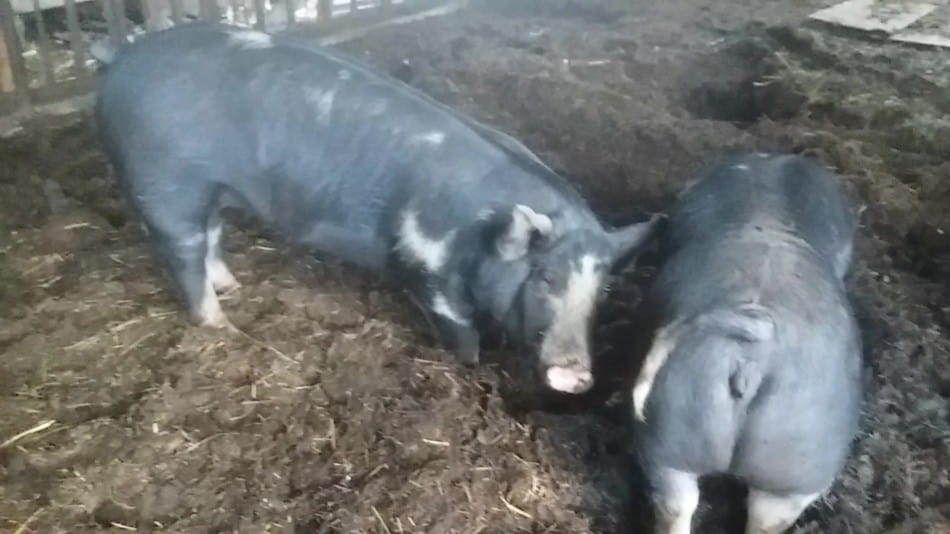
Specifics for sow selection are different than gilts
- Good body condition-not too fat or thin
- Good movement-watch her walk around
- Good underline with 14+ functional teats
- Good workable attitude-a 500 pound meany is not safe to work with
Ask how she did last time farrowing and why is she being sold? Don’t let a bit of age throw you off of a great breeding sow.
As long as she is in good body condition and has a good attitude, sows are a great choice for you to get started with.
Frequently, the breeder has limited barn space and needs to make room for a younger gilt or two so the older sows are being moved out.
These gals have some great potential for you since they know what they are doing, and, for now at least, you don’t.
Deal Breakers: Sickness, underweight, sloppy fat, aggression towards people
Specifics for boar selection, he’s an athlete
- Good body condition-not too fat or thin
- Well grown-needs to be 8-10 months old to breed effectively
- Must be able to move freely-watch him walk around
- Too big is not workable-he will hurt your pigs especially the gilts supporting his weight
As with all pigs, a boar should have good size for his age and look healthy. It’s tempting to think bigger is better here, but not always.
As the boar ages he continues to grow, so eventually you’ll have a 700 pounder that is sucking down the feed and weighs too much to breed your females (she has to support all that weight during breeding).
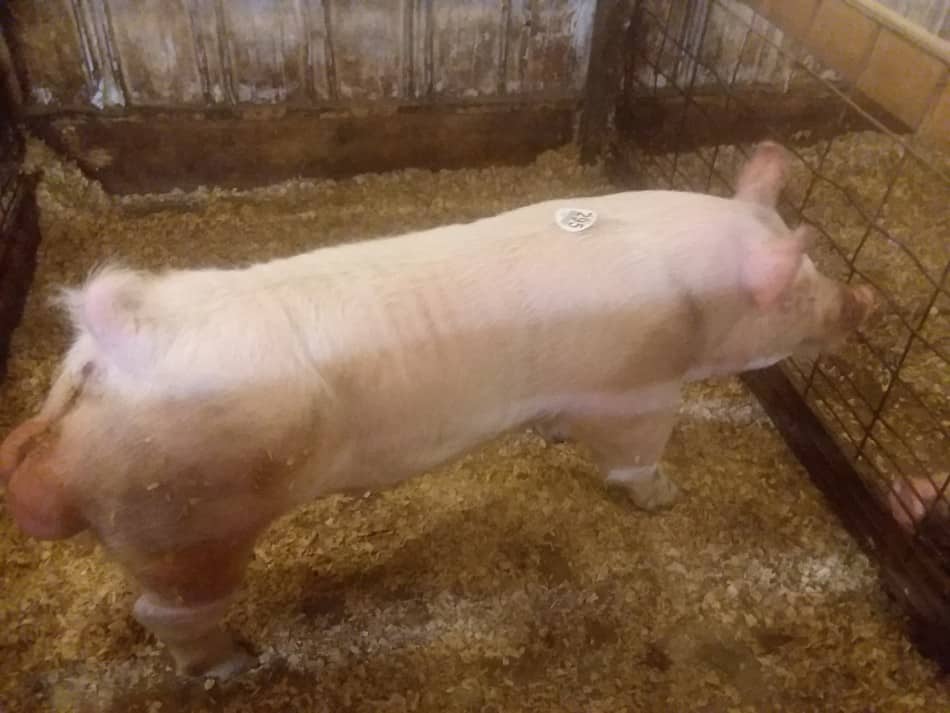
You want a boar just big enough to breed your females. Ask the farmer, he’s the expert here. He’ll have an opinion on which boar is the best choice and will be able to point out why in person.
Your boar selection will influence your pig operation more than any other choice, breeding stock wise.
Look at the outline of the boar. Does he represent the breed well?
If you’re looking for meaty, is he wide and thick? If you are looking for a maternal line boar (higher litter numbers) is he long and well grown?
Deal Breakers: huge size, restricted movement, poor body condition, aggression towards people
Sometimes you need to look elsewhere for pigs
A little story: I was at the Kidron Auction looking for a boar and saw quite a few choices that day (it’s always hit or miss).
And to my surprise, I saw a Hereford boar! I was excited to see one available, I’ve heard good things about the breed and was glad to get a closer look for myself.
Unfortunately, this boar was a very poor example of the breed. He was rangy and really only looked Hereford in the color pattern, not good genetics there.
Sad, because from the pictures I’ve seen these are a beautiful breed that would have suited me well, but this particular boar was not a good choice for anyone.
This is a cautionary tale, don’t be so in love with a breed that you buy the first ones you come across.
No matter what the paperwork or breeder says, look at the pigs in front of you.
If you were on a farm visit with a friend: would you tell your friend the pigs look good or would you tell your friend to look somewhere else?
You don’t even have to know anything about pigs to determine acceptable or not-search for images online and compare them with the pigs you have in front of you.
If the pigs are way off of what they should be, thank the farmer for his time and leave.
You’ll find more breeding stock for sale, never accept low quality because you are excited to begin.
Pig selection determine your success
The results of all of your work and planning so far are worth it-pigs that are the best fit for you and your farm!
Wise pig choice now=you happier later!
Along with the ability to choose the advantages of your breeding stock, you also have chosen the challenges of them, since no animal or breed is perfect.
All pig breeders have the same challenge:
How do you get the things you are hoping for, like pigs adapted to your specific situation, while avoid getting the things you don’t want, like poor growers or bad attitude?
You want to have pigs that will suit you and your operation.
Would you talk about your purebred stock, or mention how your sows are super easy care with wonderful attitudes?
Maybe your pig line finishes really early due to constant selection of chunky fast growers?
This is where it all starts, take your time and choose well.
Breeding stock genetics are a continual game
Getting more of the characteristics you want while eliminating or at least minimizing the characteristics you don’t want are the goals of all livestock breeders, pigs or otherwise.
Since, every one wants the same thing, this should be easy, right? No.
Genetics are a constant game of you giving it your best guess and seeing the results. Try something and then adjust to get closer to the results you need/want.
So, where to start? As always, the answer here is more about you and your goals than anything else.
Think about in five years if I were to ask you to tell me about your pigs, what would you mention as the highlight of your work with your pigs?
Plan and research before you buy your pigs
A few final thoughts on breed selection: if you are planning to spend quite a bit of money on getting your pigs or getting an unusual breed, please do your market research before dishing out the cash!
Pigs that cost more to purchase and raise will need to bring more per pound when sold for you to profit raising them.
Hopefully, you had already thought of that! Will your area support the prices you need to make your pigs profitable?
In my area, Ohio, anything unusual pig wise brings the most money through private sales.
That’s the glass half full way of saying unusual pigs sell very poorly at auctions as market hogs or feeder pigs. To get decent money, these characters are private sale only.
Raise pigs that excite you and will fit well into your farm management system from farrowing clear through to final customer. Good Luck getting started with pigs!
When you have a bit of time, read Dr. Michaela Giles series of articles on pigs. This series is wonderfully informative, yet easy to understand and written with a small farmer in mind.
